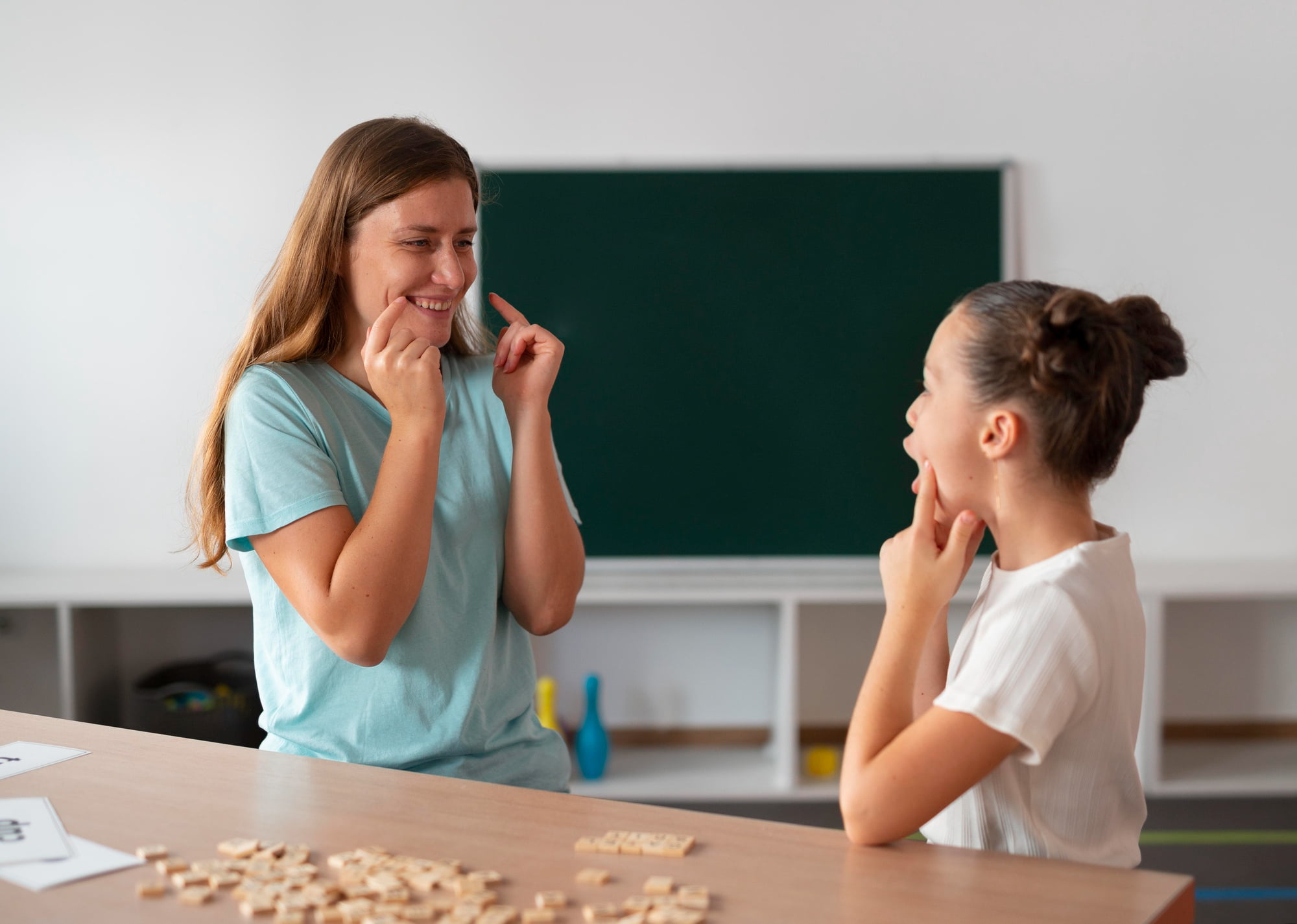


Oral language development involves the process by which a child learns and develops language skills, such as understanding and using spoken language for communication. It includes various abilities, such as listening, speaking, vocabulary building, and comprehension.
During early childhood, children learn language primarily through their interactions with caregivers and the environment. These interactions help them understand the meaning and structure of words and sentences and develop effective ways to express their thoughts and ideas.
As children grow and develop, their oral language skills become more advanced, including using complex grammatical structures, vocabulary, and communication strategies. Having strong oral language skills is vital for academic and social success, as it helps children communicate effectively, learn new information, and express their thoughts and ideas clearly.
Parents, caregivers, and educators play a significant role in supporting oral language development by engaging children in conversations, reading aloud, providing enriching language experiences, and creating real-life opportunities for language practice. Through effective support for oral language development, we can help children acquire the skills needed for effective communication and success in life.
Phonology, one of the five stages of oral language development, focuses on the sounds of a language and how they form words and sentences. Children develop the ability to recognize and produce different sounds, such as vowels, consonants, and diphthongs, and use them correctly in language. This stage involves learning to distinguish between sounds and understand how they combine to form words and sentences. Children also become familiar with the phonological rules of their language, which enables them to speak and understand language more fluidly. Phonology is a crucial phase in the development of oral language skills, as it sets the foundation for further language development.
Another stage of oral language development is vocabulary, which focuses on a child’s understanding and use of words. Children acquire new words through exposure to language and direct instruction, starting with basic words and gradually building a more extensive and sophisticated vocabulary. Developing a strong vocabulary is essential for effective communication, enabling children to express themselves clearly and understand others. Moreover, it supports literacy skills such as reading and writing, as children are better able to comprehend and use language. Vocabulary is a critical stage in oral language development as it lays the groundwork for later stages of language development.
Another crucial stage of oral language development is grammar, which involves the rules governing the structure of words and sentences in a language. During this stage, children learn to use grammatical structures, including verb tenses and sentence types, and to use them appropriately in their speech. They gradually acquire the rules of syntax, which aid them in constructing more intricate and refined sentences. The development of grammar is critical for effective communication, allowing children to articulate themselves more clearly and understand complex language. A strong foundation in grammar also supports literacy skills, such as reading and writing.
The stage of oral language development known as pragmatics is crucial, as it focuses on the social rules of language. Children learn how to use language appropriately in different social situations and understand the meanings and intentions behind different types of language use. They learn to adjust their language use based on the needs of their listeners and to use language to achieve their communication goals. Pragmatics involves understanding nonverbal cues, such as body language and tone of voice, as well as the cultural norms of language use. A strong foundation in pragmatics is essential for effective communication and social interaction, both in oral and written language.
The discourse stage of oral language development is critical as it focuses on the larger structures of language. Children learn to organize and communicate ideas in longer texts, such as stories or essays. They learn how to use discourse markers and connective language to link ideas together and create coherent and meaningful texts. Additionally, they develop an understanding of different genres and text types, adapting their language use to suit the context and purpose of communication. A solid foundation in discourse not only supports academic success but also effective communication in various settings, making it an essential stage in oral language development.

Exposure to language plays a crucial role in oral language development. Children need frequent engagement with language to develop their language abilities. They should be exposed to the language spoken by caregivers, family members, and others, as well as a wide range of words and language structures in their environment. Young children learn language through observation, imitation, and repetition, so it is essential to provide them with rich language experiences.
Parents, caregivers, and educators can support exposure to language by engaging children in conversations, reading aloud, singing songs, and providing opportunities for children to interact with a variety of people and experiences. By frequently exposing children to language, we can support the development of strong oral language skills.
Interacting with others is a crucial factor in developing oral language skills. Engaging in conversations, storytelling, and play helps children develop their oral language abilities. Parents and caregivers can support children’s interaction by engaging them in dialogues, asking open-ended questions, and encouraging them to express their thoughts and ideas.
Children frequently engaging in language interactions are more likely to develop strong oral language skills. Caregivers need to create a supportive environment that enables children to express themselves and ask questions comfortably. Through interaction, children develop not only their oral language skills but also crucial social and emotional skills that will benefit them throughout their lives.
Reading is an essential component of oral language development as it helps children develop their vocabulary, grammar, and comprehension skills, and exposes them to different types of language. Parents and caregivers can read aloud to children from an early age and encourage reading as they grow.
It provides an opportunity to discuss characters, settings, and events, and develop critical thinking skills. Reading promotes a love of learning and is a great way to bond with children. Incorporating reading into daily routines can support children’s oral language development and help them become lifelong readers.
Play is an essential component that actively supports oral language development. It allows children to practice and experiment with language in a fun and engaging way. Through play, children can use language to interact with others, express their thoughts and feelings, and explore new ideas and concepts. Play provides children with opportunities to use language in meaningful contexts and to develop their communication and problem-solving skills.
Parents and caregivers can actively support language development through play by engaging in games, role-playing, and storytelling activities. These experiences can help children develop their creativity, imagination, and language skills, and also foster their social and emotional development. By incorporating play into daily routines, we can actively support children’s oral language development and help them become confident communicators.
Direct instruction is an essential component of oral language development, as explicit teaching of phonology, vocabulary, grammar, pragmatics, and discourse can facilitate the development of language skills. Such instruction can be particularly beneficial for children who face difficulties with language or who are acquiring a second language.
Educators and caregivers can employ various approaches, such as modeling, providing feedback, and using visual aids, to teach specific language skills. Direct instruction can also enhance children’s understanding of language mechanics and improve their communication skills. By providing targeted instruction, we can help children strengthen their oral language abilities and enhance their academic performance.
Multimodal experiences play an important role in oral language development as they provide children with a variety of experiences, such as music, drama, and art, that can help develop their oral language skills. Through these experiences, children can express themselves in different ways, develop their creativity, and improve their language abilities. For example, music can help children learn rhythm, intonation, and pronunciation, while drama activities can improve storytelling and social skills.
Art activities can also assist children in learning new vocabulary and concepts. Encouraging children to explore and express themselves through different modes of communication is essential in supporting their oral language development and helping them become confident and competent communicators. Providing children with a range of multimodal experiences is vital.
The first stage of oral language development starts at birth and lasts up to six months. During this stage, infants produce sounds such as cooing and babbling. Cooing involves the production of vowel-like sounds while babbling involves combining consonant and vowel sounds. Infants at this stage also demonstrate the ability to distinguish between different sounds and voices.
During the stage of single words, which lasts from six to 18 months, infants begin using individual words to express their needs and want. At this stage, they experience a quick expansion in their vocabulary, as they learn to associate words with objects and actions. Infants also begin to use gestures like pointing and waving to communicate their messages.
The third stage of oral language development occurs around 18-24 months, as toddlers begin to combine words into two-word phrases. These phrases typically consist of a noun and a verb, such as “want milk” or “play ball.” Toddlers at this stage also start to understand and use pronouns like “me” and “you.”
This stage is marked by a continued expansion of vocabulary, as toddlers learn to associate more words with objects and actions in their environment. They also start to use language to make requests, ask questions, and make comments, demonstrating an increasing awareness of the social function of language.
Between the ages of two and three years, children enter the fourth stage of oral language development. At this stage, children begin to form longer sentences and use more complex grammar. They begin to understand and use past and future tenses, and they ask questions using words like “why” and “what.”
Children also start to develop a better understanding of language structure and syntax, which allows them to form more complex sentences. This stage is a crucial period for language development, as it sets the foundation for future language skills and the ability to communicate effectively with others.
Between the ages of three to five years, children enter the fifth stage of oral language development, during which their language skills continue to develop. They start to use more complex sentences, including compound and complex sentences. Additionally, they use descriptive language and learn new vocabulary at a rapid pace.
At this stage, children also begin to understand and use figurative languages such as idioms and metaphors. Using these language structures enables children to convey their thoughts and ideas effectively and engage in more sophisticated conversations. Continuing to support language development during this stage is crucial by providing opportunities for children to practice and expand their language skills.
Do you want to Know about Indigenous History Of Australia : https://mycollegeassignment.com/indigenous-history-of-australia/
Stressed about assignments? Get help from our experts! Visit https://subjectacademy.com/ Now
For more Details:https://mycollegeassignment.com/